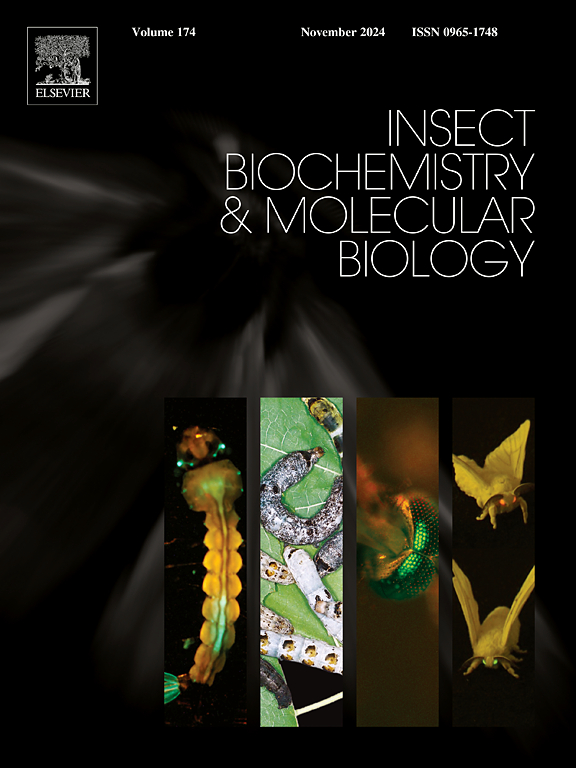NlAgo3 and NlBiwi are essential for piRNAs biogenesis and female reproduction in Nilaparvata lugens
IF 3.7
2区 农林科学
Q2 BIOCHEMISTRY & MOLECULAR BIOLOGY
引用次数: 0
Abstract
P-element-induced wimpy testis (PIWI) -interacting RNAs (piRNAs) are short non-coding RNAs crucial for silencing transposable elements (TEs) and maintaining genome stability, particularly in germ cells. While most research on piRNAs and PIWI proteins has traditionally focused on model organisms such as Drosophila, emerging studies are now extending to other insect orders. However, little is known about piRNAs in insects of the Hemiptera order. Here, we investigated the role of piRNAs in the brown planthopper (BPH), Nilaparvata lugens, a significant pest of rice that belongs to the Hemiptera order. We identified and characterized two PIWI subfamily protein genes in N. lugens: NlAgo3 (a homolog of Ago3) and NlBiwi (the BPH Piwi). Both proteins contain Piwi/Argonaute/Zwille (PAZ) and PIWI domains. Sequence alignment and phylogenetic analysis demonstrated that NlAgo3 and NlBiwi are conserved across other insect orders. NlAgo3 and NlBiwi are highly expressed in female adults and their ovaries in N. lugens. Importantly, knockdown of NlAgo3 and NlBiwi significantly impaired eggs laying, leading to female sterility, suggesting that these proteins play a crucial role in female reproduction in N. lugens. Subsequently, through small RNA sequencing, we characterized piRNAs in N. lugens and identified a length peak in the range of 26–28 nucleotides, with differences in piRNA abundance between females and males. Additionally, we observed that piRNA clusters were distributed across each chromosome, with a higher density on the sex chromosomes. Moreover, RNAi-mediated knockdown of NlAgo3 and NlBiwi severely impaired piRNA production in BPH, highlighting that these proteins are essential for piRNA biogenesis in N. lugens, consistent with findings in other species. Overall, this study provides valuable insights into the role of piRNAs in the reproductive biology of N. lugens, a major pest of rice. By elucidating the characteristics of piRNAs in this insect species, this research enhances our understanding of piRNA-mediated gene regulation in Hemiptera insects. These findings have potential implications for the development of novel strategies for pest control.

NlAgo3和NlBiwi在褐飞虱的pirna生物发生和雌性生殖中起重要作用
P-element-induced wimpy testis (PIWI) -interacting RNAs (piRNAs)是短的非编码rna,对于沉默转座因子(te)和维持基因组稳定性至关重要,特别是在生殖细胞中。虽然大多数关于pirna和PIWI蛋白的研究传统上都集中在像果蝇这样的模式生物上,但新兴的研究现在正在扩展到其他昆虫目。然而,对半翅目昆虫的pirna知之甚少。在这里,我们研究了pirna在褐飞虱(Nilaparvata lugens)中的作用,褐飞虱是一种半翅目的水稻害虫。我们在N. lugens中鉴定并鉴定了两个PIWI亚家族蛋白基因:NlAgo3 (Ago3的同源物)和NlBiwi (BPH PIWI)。这两种蛋白都含有Piwi/Argonaute/Zwille (PAZ)和Piwi结构域。序列比对和系统发育分析表明,NlAgo3和NlBiwi在其他昆虫目中具有保守性。NlAgo3和NlBiwi在雌成虫及其卵巢中高表达。重要的是,NlAgo3和NlBiwi的敲低显著损害了产卵,导致雌性不育,这表明这些蛋白在N. lugens的雌性繁殖中起着至关重要的作用。随后,通过小RNA测序,我们对N. lugens中的piRNA进行了表征,并在26-28个核苷酸范围内发现了一个长度峰,雌性和雄性之间的piRNA丰度存在差异。此外,我们观察到piRNA簇分布在每条染色体上,在性染色体上密度更高。此外,rnai介导的NlAgo3和NlBiwi的下调严重损害了BPH中piRNA的产生,这表明这些蛋白对N. lugens中piRNA的生物生成至关重要,与其他物种的研究结果一致。总的来说,本研究为pirna在水稻主要害虫褐飞虱的生殖生物学中的作用提供了有价值的见解。通过阐明该昆虫中pirna的特征,本研究增加了我们对半翅目昆虫中pirna介导的基因调控的认识。这些发现对开发新的害虫防治策略具有潜在的意义。
本文章由计算机程序翻译,如有差异,请以英文原文为准。
求助全文
约1分钟内获得全文
求助全文
来源期刊
CiteScore
7.40
自引率
5.30%
发文量
105
审稿时长
40 days
期刊介绍:
This international journal publishes original contributions and mini-reviews in the fields of insect biochemistry and insect molecular biology. Main areas of interest are neurochemistry, hormone and pheromone biochemistry, enzymes and metabolism, hormone action and gene regulation, gene characterization and structure, pharmacology, immunology and cell and tissue culture. Papers on the biochemistry and molecular biology of other groups of arthropods are published if of general interest to the readership. Technique papers will be considered for publication if they significantly advance the field of insect biochemistry and molecular biology in the opinion of the Editors and Editorial Board.

 求助内容:
求助内容: 应助结果提醒方式:
应助结果提醒方式:


